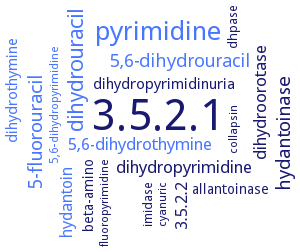3.5.2.1: barbiturase
This is an abbreviated version!
For detailed information about barbiturase, go to the full flat file.

Word Map on EC 3.5.2.1 
-
3.5.2.1
-
pyrimidine
-
dihydrouracil
-
hydantoinase
-
5-fluorouracil
-
5,6-dihydrouracil
-
5,6-dihydrothymine
-
dihydropyrimidine
-
dihydroorotase
-
hydantoin
-
3.5.2.2
-
dihydrothymine
-
dihydropyrimidinuria
-
allantoinase
-
beta-amino
-
dhpase
-
imidase
-
5,6-dihydropyrimidine
-
fluoropyrimidine
-
collapsin
-
cyanuric
- 3.5.2.1
- pyrimidine
- dihydrouracil
- hydantoinase
- 5-fluorouracil
- 5,6-dihydrouracil
- 5,6-dihydrothymine
-
dihydropyrimidine
- dihydroorotase
- hydantoin
-
3.5.2.2
- dihydrothymine
-
dihydropyrimidinuria
- allantoinase
-
beta-amino
- dhpase
- imidase
- 5,6-dihydropyrimidine
-
fluoropyrimidine
-
collapsin
-
cyanuric
Reaction
ECTree
Advanced search results
General Information
General Information on EC 3.5.2.1 - barbiturase
Please wait a moment until all data is loaded. This message will disappear when all data is loaded.
evolution
-
the enzyme belongs to a protein family that consists of only cyanuric acid hydrolase (CAH) and barbiturase. CAH and barbiturase enzymes act on structurally analogous 6-membered ring substrates, yet each enzyme is specific and does not react with the other's substrate. While most organisms utilize a reductive pyrimidine degradation pathway, some actinobacteria use barbiturase in an oxidative catabolic pathway. Unlike barbiturase, cyanuric acid hydrolases are more broadly distributed throughout bacteria and fungi. The CAH/barbiturase family includes 169 different sequences of Actinobacteria, phylogenetic analysis and tree, overview
metabolism
-
barbiturase participating in pyrimidine catabolism by some actinobacterial species. Barbiturase catalyzes the second step in the oxidative pyrimidine degradation pathway


 results (
results ( results (
results ( top
top






